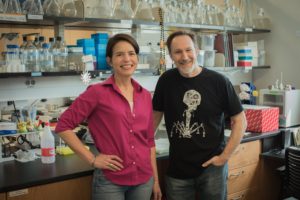
Sharon Isern and Scott Michael. Photo by Melissa Neubek.
Sharon and Scott return to TWiV for a Zika virus update, including their work on viral evolution and spread, and whether pre-existing immunity to dengue virus enhances pathogenesis.
Hosts: Vincent Racaniello, Dickson Despommier, Alan Dove, and Kathy Spindler
Guests: Sharon Isern and Scott Michael
Click arrow to play
Download TWiV 454 (65 MB .mp3, 108 min)
Subscribe (free): iTunes, RSS, email
Become a patron of TWiV!
Links for this episode
- Hurricane Zika (TWiV 410)
- 454 Corporation (Wikipedia)
- Regional Zika update, Americas (PAHO, WHO)
- Zika virus serum bank (pdf)
- Zika virus evolution and spread in the Americas (Nature)
- Multiple introductions of Zika virus in US (Nature)
- Inhibition of Zika Virus Replication by Wolbachia (J Virol)
- Zika virus pathogenesis in rhesus macaques unaffected by immunity to dengue virus (Nat Commun)
- Impact of flavivirus immunity on Zika virus infection in rhesus macaques (PLoS Path)
- Enhancement of Zika virus pathogenesis by antiflavivirus immunity (Science)
- No ADE by dengue antibodies in Zika virus patients (Clin Inf Dis)
- Oropharyngeal mucosal transmission of Zika virus in rhesus macaques (Nat Commun)
- Letters read on TWiV 454
Weekly Science Picks
Dickson – Industrial Scars
Kathy – Eclipse info by zipcode
Sharon – Michaela’s article in The Conversation
Scott – Signal P, Pecaan, Phamerator, DNAmaster
Alan – The Eagle Whisperer (and the Great Big Story channel)
Vincent – Bottle
Listener Pick
Kevin – Tenure track scientist bites the dust
Intro music is by Ronald Jenkees.
Send your virology questions and comments to twiv@microbe.tv


The persnickety thing about these Macaque studies is that they were done using sequential infections.
At first glance, you might think this is a home run: it must be essential for any study about ADE in animals to first infect with Dengue and then challenge with Zika, right?
Not so fast. Much like the oft-repeated words of Dr. Peter Palese “mice are not men,” monkeys are also not men! You can’t do infection of DENV then ZIKV in Macaques and say it’s the best test of ADE. It doesn’t match how DENV-DENV enhancement was first confirmed in macaques!
All of these studies are investigating whether or not anti-DENV immunity can enhance ZIKV, but they aren’t following the experimental design that showed the gold standard of DENV enhancing DENV.
In the seminal set of rhesus macaque studies published by Halstead et al (1973), they found that primary infection with any of the four DENV serotypes followed by subsequent infection with DENV-1 or DENV-4 a year later actually caused partial protection (reduced viremia and better HAIs). This is in contrast to subsequent infection with DENV-2, which is where they first saw enhancement (1) (2). Muddying the waters further is that studies done in the closely related cynomolgus macaque showed only cross-protection, no enhancement (3).
If this method of testing ADE (serial infections in rhesus macaques) fails to show DENV – DENV enhancement (a comparably well characterized and understood clinical phenomena), how can we expect it to show enhancement in DENV – ZIKV?
The final straw that broke the camels back of ADE in macaques, the definitive piece of evidence that showed the macaque model was useful for enhancement studies was (*intake of breath*) a passive transfer of human sera (4).
Passive transfer studies are, in my opinion, so much better for assessing ADE* because A) it shows clearly the polyclonal antibody response dependent mechanism, B) it allows for titration of the antibody response to be perfectly within the window of enhancement and outside of the window of protection, and C) because it avoids the problems of heterogeneity of immune response.
*Disclaimer: I was a co-first author on the STAT2 KO mouse study that used passive transfers.
If I have 10 (outbred) macaques and I inject each with a virus once, and then subsequently re-injected with a secondary challenge virus, I’m opening myself up to 20 separate incidences of immune responses that have to work correctly.
If I (and 9 of my friends) get infected with DENV-1, and I pool our sera together, and then inject THAT pooled sera into macaques in the right titration followed by subsequent infection with DENV or ZIKV, then I’ve hedged my bets against some of that inherent biovariability!
Until someone A) does passive transfer of anti-DENV sera in macaques followed by ZIKV infection showing no enhancement (with large n) or B) shows clear evidence of primary – secondary infection enhancement from DENV – DENV side by side with no enhancement from DENV – ZIKV, I don’t think there’s a good reason to believe these macaque models track directly with human disease.
And ultimately yes this question will be solved by epidemological studies and clinical research! I think we’ll be seeing quite a few more of this type of paper come out in the near future…
(1) https://www.ncbi.nlm.nih.gov/pubmed/4196288
(2) https://www.ncbi.nlm.nih.gov/pubmed/4198024
(3) https://www.ncbi.nlm.nih.gov/pubmed/17560694
(4) https://www.ncbi.nlm.nih.gov/pubmed/117061